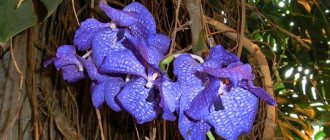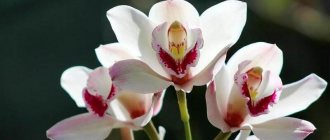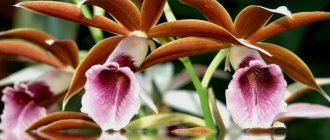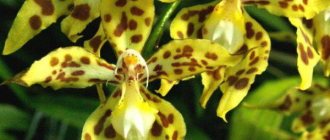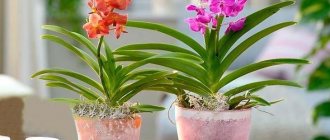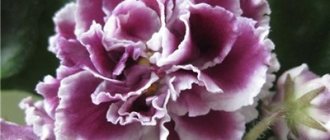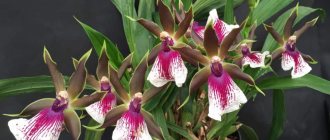Plants » Flowers
0
1652
Article rating
Kira Stoletova
One of the most exotic indoor plants is the Phalaenopsis Cascade orchid. With its unusual shape, the cascading orchid attracts attention and adds zest to the interior.
Cascade orchid
Phalaenopsis varieties
Charming blue butterfly orchid
Breeders have been breeding new varieties of the royal flower for a long time. Among them there are very rare plants. They cost a fortune.
For those new to growing, hybrids are recommended. They are easy to care for and do not require close attention.
Pleasant or Amabilis
Phalaenopsis Amabilis: white flowers with a light lilac coating on the edge of the petal
Pleasant or Amabilis
The fleshy leaves of phalaenopsis are dark green in color, arranged in 2 rows. The peduncles are long, curved in shape, and can reach 0.5 m in length.
A replacement peduncle immediately develops in place of the cut peduncle. Phalaenopsis Amabilis is a fertile material for crossing. It is this beauty that is the progenitor of many new varieties.
Flowering is long lasting. Flowers appear mainly in autumn.
Pink (Rosea)
Pink (Rosea)
Pink (Rosea)
It is considered a miniature plant. Bright pink or white flowers do not exceed 3 cm in diameter and are located on a peduncle 30 cm long.
Schilleriana
Schilleriana
Schilleriana
The beautiful exotic foliage is completely covered with silvery spots, the bottom of the leaf has a reddish tint. Huge flowers, reaching a diameter of 7 cm, hang in a beautiful cascade from long peduncles. Stems can be 0.5 m long.
Stuart (Stuartiana)
Stuart (Stuartiana)
Stuart (Stuartiana)
An interesting plant with variegated foliage and silvery roots. The variety has gained popularity due to its abundant flowering: up to 60 snow-white flowers decorated with purple spots can bloom simultaneously on one peduncle.
Phalaenopsis Cleopatra
Phalaenopsis Cleopatra
Phalaenopsis Cleopatra
An unpretentious hybrid variety with beautiful yellow flowers. The entire surface of the petals is generously dotted with burgundy specks. The flowers are large.
Phalaenopsis hybrids have an affordable price, varieties are a little more expensive.
Currently, orchid collectors are in pursuit of pelorics. This is the name of a variety of orchids (mutants) that bloom differently each time.
What flowers should you not keep at home and why? TOP 25 plants dangerous to health + Signs | (25+ Photos & Videos)
Cuttings
How to properly propagate an orchid by cuttings?
stem
For sympoidal orchid species, the method of obtaining cuttings from pseudobulbs is suitable.
Basic rules for cutting
Cut so that there are one or two kidneys on each piece.
Orchid sections must be treated with brilliant green or iodine.
All cut areas should be powdered with crushed coal. Iodine and brilliant green are not used.
Attention! Wounds on the mother plant are treated in the same way as cutting cuttings.
Planting in the substrate
The substrate must be prepared in advance. Place the cuttings in damp moss, spray with a biostimulant and be patient. In about a month, the most promising buds will wake up and delight the owner with green sprouts.
Using a mini-greenhouse for rooting
You can’t just plant cuttings and forget about the greenhouse for a month. Ventilation for a few minutes is necessary every day. It is necessary to provide light and warmth, and temperature differences between day and night within 4-7 degrees have a beneficial effect on growth.
Peduncle
Material selection
How is an orchid propagated using a peduncle? Choose a strong, healthy plant with well-developed peduncles. The branch should be:
- Tolstoy;
- Rich green color.
They begin immediately after the end of flowering, when the flowers have begun to fade, but the apical bud is still fresh. The peduncle is cut so that each cutting has one or two buds. Be sure to powder the sections with crushed charcoal, or activated charcoal. When the baby grows up, carefully cut it off the peduncle.
Important! The lower the bud was on the mother plant, the greater the likelihood of getting a strong sprout from it.
Germination medium
In order for the bud to “wake up” and develop a viable shoot, optimal conditions must be maintained for a long time:
- Bright diffused light;
- Warm humid air around 25C;
- Greenhouse conditions with high humidity.
To do this, it is good to organize a greenhouse with damp sphagnum moss, which needs to be ventilated every day. This will help avoid rotting.
Planting in a nutrient medium
The cuttings are placed in a greenhouse in a “lying” position, that is, horizontally. The greenhouse needs to be prepared in advance.
The cuttings are laid evenly so that there is a distance between them.
The prepared cuttings are laid in even rows so that there is a distance between them and as much surface as possible is illuminated.
How to propagate phalaenopsis?
Inexperienced gardeners often wonder: how to propagate an orchid without harming the plant?
Everything is simple here. By carefully examining the peduncle, you can identify dormant buds. In order for the propagation of an orchid to be successful, it will be necessary to ensure that the temperature is maintained at + 24 ... + 29 ° C. This stimulates the awakening of the primordia of future shoots. Armed with a sharp knife, you need to make a semicircular cut at the base of the bud to easily remove the scales from it. A florist who knows how an orchid reproduces will then necessarily treat the bare area with cycotin paste and cover it with sphagnum.
After 4 - 6 weeks, the plant will form babies with 2 - 3 tiny leaves. Their number depends on the number of buds treated. A florist interested in how the phalaenopsis orchid reproduces at home should know that from each epiphyte it is best to get one new young plant - strong and healthy. Otherwise, the plant, weakened by a large number of “cubs,” may die.
In the subsequent period (3-4 months), the baby’s first roots grow. A stronger specimen that has reached a length of 2 cm can be cut off from the mother and then planted in a separate container. It is recommended to cover the roots of a young orchid with moss to prevent drying out. In the room where the new epiphyte is developing, it is necessary to provide the required humidity. If this is problematic, you can limit yourself to building a greenhouse over the plant.
Quite often, flower growers are concerned with the question: how to plant orchid seeds, how successful such a procedure will be. Experience shows that such an event very rarely gives positive results.
If you wish, you can try to purchase orchid seeds and sow them, but the germination process will be long and labor-intensive. In addition, it will take about 3 to 4 years for young plants to bloom. Experienced florists who know what orchid seeds look like warn about the tiny size of the planting material, which requires professional skills to work with it.
Reproduction methods
You can propagate the Dendrobium orchid at home in two ways: through division and secondary shoots.
Division
Although this method of propagating Dendrobium is the simplest, only older, large individuals whose rhizomes can be divided are suitable for it. The cut is treated with ground cinnamon. The separated parts must contain at least four pseudobulbs. Typically, one plant produces only two new ones.
Dividing an orchid bush
The selected parts are placed in pots with a smaller substrate. Before young shoots appear, watering should be very sparse. Some gardeners recommend not watering at all for 7 days. After the first escape, you can begin caring as usual.
Cuttings
To make cuttings, old stems that have already dropped their leaves are used. At the first stage, the main task is to get children. To do this, cut cuttings treated with charcoal are placed in greenhouse conditions, which can be a plastic container, the bottom of which is lined with sphagnum. The cover must contain holes for ventilation.
Orchid cuttings in a container
The cuttings are placed directly on the sphagnum and sprayed with the growth stimulator "Epin". Then the container is placed in a warm place.
Important! The wait for children to appear can be up to six months. At the same time, constant monitoring of the greenhouse is necessary in order to ensure the required temperature, lighting, sufficient humidity, but to prevent the appearance of mold
The children are separated from the cuttings only when 2-4 roots appear, then they can be planted in a separate container.
Step-by-step care instructions
Selecting a location
This orchid is very afraid of the open rays of the sun. Experienced collectors are advised to place it on north-facing windows, adding lighting.
Preparing the soil and pot
It is better to take a transparent plastic pot; we make small holes in the sides and bottom for good air access and for a convenient location of the roots.
The pot does not need to be very large, but rather to support the roots, so choose medium sized pots. Substrate:
- Drainage - pieces of polystyrene foam or expanded clay located at the bottom of the pot.
- Charcoal – crushed pieces can be placed in the moss between the roots.
- Sphagnum moss retains moisture well and is a natural environment for orchids.
Temperature
The orchid is thermophilic, it is advisable that the temperature does not drop below 20 ° C during the day, no matter what time of year it is outside. Then it will develop well, grow, grow young leaves and soon bloom again.
Important: Sogo Orchid does not like heat, the optimal temperature is up to 28 ° C
Humidity
Sogo orchids do not require too much moisture, 50-60% is enough. They tolerate drying better than flooding. But in spring and summer it is necessary to increase air humidity. This will ensure good growth and flowering of orchids. Additional moistening is not required; it is enough to simply refresh the leaves in hot weather by spraying.
Lighting
The Sogo orchid, like all hybrid varieties of Phalaenopsis, is not capricious. Does not require any special lighting devices. In spring and summer, be sure to darken the windows so that the sun does not burn the orchid leaves. In winter, additional lighting is required; special phytolamps can be used.
Watering
If the orchids are located on northern windows, naturally, watering is not needed here as often as if the orchids were located in a “warmer” window
It is important to watch the roots. If the roots are greyish brown, you can water them
It is better not to water the flowers or spray them, so that stains do not appear on them, but the leaves can be sprayed, moisturizing the aerial roots. It is enough once every 2 weeks in the autumn-winter period, and if it is very hot, then once a week.
We recommend watching a video about proper watering of an orchid:
Top dressing
Feed your Sogo orchid usually with watering. Flower growers are recommended to water with any special rooting agent. Fertilizer regime: alternating irrigation with plain water and irrigation with fertilizer. As soon as the buds appear, water only with water, without fertilizer. The main thing is to do no harm.
Transfer
- You will need to remove the orchid from the pot, then soak the orchid along with the earth in a solution of epinic and succinic acid. We also soak coconut chips and sphagnum moss.
- It is transplanted using the method of transshipment with the original substrate (if the orchid is healthy).
- If there are diseased, decayed roots, then you will need to clean the roots.
- We lower the renewed and treated orchid into a new pot.
- Fill the space of the pot with the prepared substrate, without pushing it.
- We place the orchid in a large container, water it well so that moisture penetrates the entire new substrate. Excess water gradually drains through the holes. Use a cotton pad to remove water from the leaves and growing points to avoid rotting.
We recommend watching a video about the features of transplanting a Sogo orchid:
Selecting a quality substrate
The usual soil in which other indoor flowers are planted is not suitable for orchids. This species feels best in a pot filled with pine bark. The bark of other trees is also not recommended. The optimal composition of the substrate includes pine bark, charcoal and large expanded clay in a ratio of 2:1:1. Each component in this mixture has its own role: coal and expanded clay accumulate water, which is then gradually released to the bark, which allows you to create an optimal level of humidity for the plant in the pot. In addition, thanks to charcoal, the bark does not rot, and mold and fungi do not appear on it.
The best option is to purchase a ready-made substrate in a store. As to whether it is worth taking soil for orchids with the addition of sphagnum, opinions are divided: some believe that these components can cause stagnation of moisture and rotting of the plant. But you can save money and prepare the bark yourself: collect it from fallen trees in the forest. Before use, the bark must be cut into small pieces, boiled and dried: this will protect it from the formation of fungus and mold.
Answers to popular questions from flower growers
Many gardeners are interested in the question of how to care for phalaenopsis at different periods of its life to maintain health and abundant budding.
Is it possible to revive an orchid without roots?
Errors and inaccuracies in care can lead to loss of roots, buds and loss of leaf turgor. To save such specimens, it is necessary to try to revive them.
In case of complete or partial loss of roots, you must:
- replace the substrate with a fresh one;
- exclude watering, irrigate only the soil surface and leaves;
- if the roots are completely lost, place the orchid in a container with damp sphagnum moss.
An alternative method is to secure the socket in a container above the water.
Apply watering and fertilizing through pollination of leaves from a sprayer. It is necessary to take diligent care of such plants until young roots grow.
How to rejuvenate phalaenopsis
Old overgrown bushes can be rejuvenated by dividing the orchid into two parts - upper and lower. Such plants lose their aesthetic appearance and bloom very sparingly and rarely.
The presence of a large number of aerial roots on the orchid trunk indicates readiness for rejuvenation
A month after division, the upper division will grow young roots, the lower one can produce basal children. At this time, you can begin to apply fertilizers. The dose of the drug must be reduced by 2 times.
Is it possible to propagate phalaenopsis from seeds?
Growing phalaenopsis from seeds is very difficult, but possible. To do this, you will have to create a semblance of sterile laboratory conditions in the apartment. You need to be prepared that the process of growing an orchid from seeds will take a lot of time and effort.
Even experienced and skillful flower growers do not always manage to get long-awaited babies. If the outcome is favorable, you can become the owner of a rather impressive collection of “babies.”
Nuances of caring for painted phalaenopsis
Caring for painted orchids is not particularly different from usual care. However, the viability of such plants is significantly reduced. Chemical dyes negatively affect the health of phalaenopsis.
When purchasing, you need to think about whether it is worth purchasing a painted phalaenopsis? The price of such plants is an order of magnitude higher than that of ordinary orchids. When flowering again, the buds will inevitably acquire a natural white color.
Phytolamp - when additional lighting is needed
Phytolamp for phalaenopsis plays a key role for active development and timely flowering. Orchids require additional lighting from the onset of autumn until spring. The phytolamp allows you to extend the duration of daylight hours to 12-16 hours.
It is permissible to refuse additional lighting. Phalaenopsis can easily do without a phytolamp. However, there is a possibility that a lack of lighting can slow down the growth and flowering of an orchid.
Description
It is not for nothing that the Royal Phalaenopsis orchid bears this name; this variety is truly worthy of a queen.
The standard has impressive dimensions and unusually large and beautiful flowers, and the light delicate smell only confirms its high origin.
The variety was bred in a special way and patented not very long ago. His parents still delight the eyes of the local population in the tropical forests of Australia and Indonesia.
In addition, the same varieties of wild phalaenopsis are distributed throughout almost all of Southeast Asia. It’s not for nothing that locals call the orchid “Queen of the Tropics.”
Royal phalaenopsis has the following characteristics:
- large dimensions of the trunk;
- large flower sizes;
- tall peduncle;
- moderate leaves.
Usually their cost is an order of magnitude higher than that of conventional types, they are not picky about care, and like all orchids they love watering and long-term lighting.
Photo of a blooming Royal Phalaenopsis.
External characteristics of Phalaenopsis Kaleidoscope
It is difficult to pass by and not notice a beautiful orchid 70 cm high and an inflorescence of bright 9 cm flowers.
This is a substantial orchid, it loves to be the center of attention and does not tolerate crowded spaces, so you won’t be able to save space with it.
Phalaenopsis leaves are smooth, dark green, fleshy, and well textured. They are large and long, more than 25 cm. They tend to grow fan-shaped, so the flower cannot be limited on any side.
The kaleidoscope is distinguished by the rapid growth of airy, spider-leg-like roots sticking out in different directions. They are powerful and strong.
The flower is dense in texture, with a light velvety surface of orange-yellow shades
The kaleidoscope orchid is shaped like a butterfly fluttering in the tropics.
Recently, on European forums, some experienced flower growers have been disputing the fact that phalaenopsis kaleidoscope has no smell. They claim that a true hybrid, when properly cared for and grown in a favorable environment, has a rather sweet and heavy aroma in the evening.
When can I transplant?
Reproduction of orchids is a rather difficult stage. Here the gardener should exercise maximum care and vigilance. It is also not recommended to rush. It is necessary to plant the baby of this flower at the right time so that no problems arise in the future with the young shoot. Let's consider all the main points that should be taken into account when choosing the time to transplant this spectacular and demanding plant.
One of the indicators of readiness is regrown rhizomes. Until you notice them, you don’t need to touch the shoot, otherwise it simply won’t take root and take root in its new location. The roots must be healthy and strong. Their length should not be less than 5 cm. Please note - the larger and longer the roots of the baby, the greater the likelihood that transplanting to a new place will be successful, and the plant will definitely take root in unusual conditions
There is no need to separate the shoot if you notice less than three roots on it.
You should also pay attention to the number of true leaves. Young plants can produce at least 5 flowers
Once separated from the base, the chances of survival for these specimens remain quite high. We should not forget that high-quality and healthy leaves mean proper nutrition of the plant from sunlight, as well as its respiration.
It is also necessary to take into account the period during which the baby was on the mother plant. This period should not be less than 8 months. Experts even recommend waiting until about a year has passed after the process appears. Growing a rhizome system is a long and difficult process.
If you want to properly plant and propagate this gorgeous plant, then you need to take into account all the listed nuances of the replanting period. You should not rush with this procedure, otherwise the baby may simply not take root, since its root system will not be fully developed. For the roots to grow, these elements usually require at least six months. Until this moment, the baby feeds from the mother plant.
Diseases and pests
Poor care, contaminated substrate, high humidity lead to the development of diseases or pests. The condition of its leaves, small rashes on the petals and the condition of the substrate help determine what is wrong with a flower. If the leaves rot, wither, or develop a characteristic colored rash, this is a clear sign of disease or the presence of pests. In such cases, chemicals that successfully fight diseases and pests help. Such as:
- "Doctor Foley";
- "Brexil Combi";
- "Pokon";
- "Agricola";
- "Fasco".
To treat a flower, collect all fallen leaves, remove infected areas on the plant, and sprinkle with coal dust. The flower is treated with one of the rescue products and the substrate is changed.
Prevention
To prevent infection, first of all, carefully select a flower, soil and substrate without signs of disease.
How does the peduncle appear?
An orchid peduncle is a shoot that differs from the root shoot by its pointed end and scaly covering. The peduncle appears from the leaf axil and grows in any direction, curving bizarrely.
From a growing point and a waiting bud
Sometimes there are deviations in the growth of the peduncle and it can develop from a growing point, and during repeated flowering, from a waiting bud located on the previous flower shoot. In this case, there is no need to panic, just be more attentive to the changed conditions. During this period, the orchid is most sensitive to various stresses.
If a new peduncle appears on the peduncle, it means that the old flower arrow has not yet dried out and continues to live. This phenomenon occurs when the orchid finishes flowering in the spring. When a new peduncle appears, a small number of buds are formed on the old one, and its growth is observed to the side of the main stem.
In this case, the plant needs to be given more light, increased humidity and fed with special fertilizers for orchids. If the phalaenopsis looks weakened, then the peduncle should be cut off after the first flowering.
How to prune
When the plant has flowered, it needs to be pruned. Since this type of orchid can bloom several times in a row, make sure that the plant is not going to do this again, to do this, observe the peduncle: is it drying out, or are there still buds left on it? If there are no signs of new blooms within a few weeks, pruning can be done. To do this, carefully cut the stem with pruning shears, leaving nodes in the places where the flowers were. This will result in new blooms lasting 8-12 weeks and the plant will have stronger stems and larger flowers.
How to determine when a plant will bloom? The general time for all orchids to start flowering is the end of spring. Also remember what time of year you purchased your flower: if it bloomed then, it will most likely bloom at the same time in the future.
Features of planting varieties with high decorative properties
The stems of the varieties described above can be replanted not only after flowering; some gardeners recommend changing the soil during this period.
The main requirements for the substrate for such phalaenopsis:
- The mixture should contain pieces of bark of different sizes, the ratio of large and small fractions is approximately 8:2;
- Small inclusions of lumps of peat are allowed.
You also need to be able to choose a vessel; a transparent plastic pot is ideal for this. You should take it a little more than the previous one.
To create a more sophisticated design for planting phalaenopsis, you can use clay bowls. But this is provided that you can carry out the correct watering regime without looking at the roots.
The transplant is carried out in the standard way:
- Take the plant out of the pot;
- Free the roots from the old substrate as much as possible;
- Dry and rotten roots are cut off and the cuts are processed;
- Drainage is placed at the bottom of the prepared pot;
- Place the root system of the orchid and carefully distribute the pieces of bark.
You can use clay pots to create an exquisite design. The main thing is not to forget to water on time.
After this, the plant is left alone for 10-14 days, it is not watered, not turned, or fed.
Advice! Before planting in a new substrate, the phalaenopsis rhizome can be fed by soaking it in a special nutrient solution. It can be prepared using store-bought fertilizers or from natural products at home.
Growing orchid Cascade
Growing phalaenopsis at home is a painstaking task: the plant is demanding, and its care must be of high quality.
Phalaenopsis Cascade loves light, it has a special temperature regime and watering regime.
To help the cascade orchid develop and grow, a substrate is used. There is a way to prepare it at home or purchase it at a specialty store. The substrate contains:
- bark of tree,
- crushed pine cones,
- moss,
- peat.
Such a nutrient medium affects the condition of the indoor plant and improves its flowering.
Landing
Phalaenopsis Cascade orchid is planted mainly in transparent plastic pots with good air circulation. Such a container makes it possible to control the condition of the substrate and soil, as well as let in a lot of light, which is important for a cascade orchid. Before planting, the condition of the root system is checked. If the roots feel limp or dry to the touch, or begin to rot, they must be removed. After the operation, the root is treated with coal dust. The container for planting is also sterilized with boiling water or a 2% garden solution.
Planting the Cascade orchid
Propagation by seeds
Growing Phalaenopsis Cascade from seeds is a difficult and time-consuming task. At home, they try to protect seeds from rot or viral diseases. To grow a healthy plant, the seeds are first disinfected. To do this, they are placed in a 2% hydrogen peroxide solution for several minutes. The glass container for planting is also washed; it is preferable to choose a test tube or flask. The prepared nutrient medium is placed in the container, and seeds are planted on the surface. After emergence, the sprout is transplanted into a larger pot.
Reproduction by sprout
The cascade orchid grows wonderfully through sprouts. Caring for pruning is not as painstaking as caring for seeds. You should not cut off a young sprout if its roots are still too small. The sprout is cut off and planted separately, waiting until the roots have grown by at least 5 mm. After the baby is cut off, it is placed in a transparent pot half filled with soil. Peat with rotted bark is used for soil. The shoot is placed in the middle, evenly distributing the root system over the surface. The substrate is poured on top. After this procedure, the pot is placed in the brightest place in the room so that the sprout receives a lot of sunlight.
Plant care
An important condition for phalaenopsis is light; the rays of the sun should be diffused, but under no circumstances direct. Phalaenopsis is rarely watered. There will be no benefit from excessive watering; the plant will begin to rot. High humidity is a direct path to the development of viral diseases, fungi or the appearance of pests. For good growth, the flower is periodically sprayed or moistened with a warm shower. Drafts harm the plant - when ventilating the room, the flower is moved away from the open window.
Bloom
The standard will delight you with flowering regularly. To do this, just follow simple rules:
- adhere to the necessary watering rules;
- Avoid exposure to direct sunlight;
- in the autumn-winter period, “increase” daylight hours using special lamps;
- feed moderately.
Only after this, at the beginning of spring, Kaoda will release an arrow or two, on which, after some time, flowers of rich color will gradually begin to bloom.
The flowering period can last from 2 to 5 months, everything will depend on external factors and the microclimate surrounding the tree.
Kaoda can bloom for up to 5 months.
After the last flower fades and falls, do not rush to cut off the arrow. Over time, new branches with buds may begin to develop from it.
Growing conditions at home
Creating optimal conditions is the key to the health of the orchid and its lush flowering. The tactics for caring for Kaleidoscope are in many ways similar to the norms for growing other phalaenopsis.
Temperature, humidity and light
The kaleidoscope prefers partial and even complete shade to bright sunlight.
The best for Kaleidoscope will be morning and evening sun, and this is the north-west exposure of the window
This arrangement allows the orchid to have a lot of "indirect" light in the morning and some direct sun after 5 o'clock in the afternoon. In such conditions, phalaenopsis feels great and does not need shading.
It can withstand sudden short-term temperature changes from +15 °C to +32 °C. At high rates it does not bloom.
Suitable substrate
The best growing medium for the kaleidoscope orchid is rough bark mixed with pieces of charcoal and ceramis.
The soil should retain moisture without impeding air flow and allowing roots to grow freely in all directions
Main characteristics of the substrate:
- looseness and water permeability;
- moisture capacity;
- resistance to destruction and the action of soil fungi;
- lack of salinity.
Its nutritional value is not important, since it is adjusted by the fertilizers used.
The substrate can be composed of a mixture of medium-fraction bark, charcoal, sphagnum moss, and perlite.
Watering and fertilizing scheme
Baldan's kaleidoscope is a real “water bread” and requires constantly moist soil.
It is most often grown in closed pots or a “wet heel” system, when the bottom layer of the inner pot with the plant is constantly covered with water by half a centimeter. As it is used up, fresh water is added to the outer pot.
When kept open, the frequency of watering depends on the size of the pot and the plant itself, external temperature, humidity, etc.In any case, constant waterlogging of the soil and prolonged stagnation of water are harmful to the orchid and threaten the appearance of rot. The roots should dry out between waterings, but the soil should not be allowed to dry out.
Orchid watering standards:
- winter period - once every 7-9 days, in case of too dry and hot microclimate (close to the battery) - once every 5 days;
- spring-autumn – once a week;
- summer season - every 3-5 days.
1-2 times a week the kaleidoscope is sprayed with a fine spray. Large drops entering the rosette or axillary areas of the leaves are unacceptable.
Fertilize the leaves weekly 2 times in a row, the third irrigation with clean water. The procedures are carried out during the period of phalaenopsis growth and formation of the flower arrow.
Important features of orchid propagation
In order for the propagation procedure to be carried out correctly, it is necessary to provide the orchid (parent plant) with the necessary conditions during the procedure. Their provision must be carried out regardless of which method of obtaining new flowers you choose. Let's look at the mentioned conditions in the table below.
Table 1. What conditions must be observed when propagating orchids
| Condition | Details |
| Maintaining the correct life phase of an orchid | Orchids are best propagated at the end of the flowering phase, when the flowers are already clearly beginning to fade. At this moment, the flower’s resources are not concentrated on anything, therefore, the plant can use them to successfully go through the reproduction stage. |
| Ensuring the right level of humidity | In order for the task you have planned to go smoothly, you need to create ideal conditions for the flower. In particular, it is necessary to provide the plant with a suitable level of humidity, which in this case will be from 50% to 80%. The desired indicator is optimal, and the use of a humidifier will allow you to achieve it. |
| Air temperature | In order for the flower to feel completely ready for reproduction, it is necessary to keep it in a warm place for most of the day, the temperature in which is at least 28 degrees Celsius. It is in this heat that the orchid will generate the greatest amount of energy that it will need to reproduce. |
| Flower health status | To successfully obtain new small orchids, you must choose a flower that does not have any diseases as the parent. Thus, a plant infected with a dangerous disease usually looks very untidy: with yellowing leaves; covered with black mucus; with black dry leaves and roots, etc. Such a plant cannot be propagated for several reasons: even if the orchid “babies” survive, they will constantly get sick; “babies” may not take root and die; the parent plant may also die, losing a significant amount of resources during reproduction. |
As you can see, it is important to comply with the conditions not only in order to get healthy offspring from the flower, but also to ensure that the nurtured and beloved plant itself, which has been pleasing to the eye so many times and probably cost a lot, does not die after the propagation procedure
When starting to propagate an orchid, you need to remember that it is important not only to get new plants, but also to maintain the health of the parent flower
External characteristics
Mature plant height
Phalaenopsis has virtually no stem, and the height of the plant is determined by the size of the peduncle. In "Singalo" in adulthood it is 15-30 cm.
Apparently this depends not only on the place of pinching, but also on the original form of the hybrid, if there are marketing ploys in reality.
Number of leaves
The leaves grow quite quickly. The maximum observed length is about 18 cm. The number varies from 3 to 6 leaves.
Diameter, flower shape
The Singolo orchid has large flowers.
The flower shape is standard phalaenopsis. Some gardeners do not like the side petals that are too large and resemble elephant ears.
Apparently this is due to the large size of the flower, which usually even exceeds 13 cm in diameter. The diameter of the flower was observed to reach 15 cm.
Intergeneric hybrids
It will be correct if in this article we talk about intergeneric hybrids between Phalaenopsis and other related genera of orchids, such as Doritis, Renanthera, Ascocentrum, Rhynchostylis, Paraphalaenopsis, Neqfinetia ). Each intergeneric hybrid has its own name. Here are some of them: Doritaenopsis l-Hsin “Spot Eagle”, Doritaenopsis Taiwan “Red Cat”, Doritaenopsis Purple Gem, Doritaenopsis Tzu Chiang Sapphire.
Doritaenopsis Liu's Sakura 'KF#2'
Thus, before the latest changes in the taxonomy of orchids, Phalaenopsis pulcherrima was called Doritis pulcherrima, and all hybrids between it and representatives of the genus Phalaenopsis were given the name Doritaenopsis. Thus, many hybrid phalaenopsis known to domestic orchid lovers are dorithenopsis. "Doritaenopsis Liu's Sakura 'KF#2'" caused a particular stir. It is a compact plant with dark, dense leaves and a slight purple tint. Its petals are a delicate pearlescent pink shade and have a very interesting shape, which makes the inflorescence look surprisingly elegant.
Blue hybrids
Such specimens appeared in culture recently, after the discovery in nature of the blue forms of Phalaenopsis violacea coerulea, Phalaenopsis equestris cyanochilus and Doritis pulcherrima coerulea. Blue coloring is not typical for orchids. Getting a Phalaenopsis orchid with soft blue flowers has always been the dream of breeders. When we found natural blue Phalaenopsis with small flowers, joy knew no bounds.
Doritaenopsis Siam Treasure “Blue” was obtained by crossing Phalaenopsis Pleasant and Doritanopsis Most Beautiful
Selection work has not greatly improved the appearance of blue Phalaenopsis: their flower stalks produce almost white flowers with a slight gray-blue tint or medium-sized purple or pink-blue flowers. The following varieties of blue hybrids have become available to domestic collectors: Doritaenopsis Siam Treasure “Blue”, Doritaenopsis Kenneth Schubert “Blue Angel”, Doritaenopsis Purple Martin “KS”, Doritaenopsis Peter “Blue Sky”.
Phalaenopsis pelorica
Sometimes, as a result of a plant mutation, not only the leaves, but also the flowers suffer. They have an incorrect corolla structure, resulting in the formation of abnormal, almost actinomorphic “butterflies”. For example, some flowers have petals or sepals that have the shape and color of lips. For others, the lip looks like petals. Such specimens are called pelorics. They look very unusual. In nature, Phalaenopsis pelorics appear as a result of exposure to certain environmental factors. A similar phenomenon is typical for varieties such as Phalaenopsis Stuartiana, Phalaenopsis pulcherrima or Phalaenopsis Schillehana.
In floriculture in general, unusual deviations from shape arouse increased interest. Likewise, pelorics are popular among Phalaenopsis. An example is the following hybrids: Phalaenopsis Bubble Gum “Shwartz”, Phalaenopsis Terradyne “Muligan”, Phalaenopsis World Class “Big Foot”.
Phalaenopsis Bubble Gum "Schwartz"
Please note that Phalaenopsis pelorics obtained by cloning are on sale. This means that during the next flowering, in such plants, peloria may appear in a completely different form.
Many lovers of not only orchids, but also other exotics began to search for and collect such “miracles”.
In addition to the Phalaenopsis varieties described above, the following hybrids are popular in Russia:
Legato (Phalaenopsis Legato) has flowers painted in amazing colors of gold, pink, lilac with pearlescent iridescence
Phalaenopsis Cleopatra blooms for a long time with pearly yellow flowers with lilac and pink specks
Singolo (Phalaenopsis singolo) has one flower on a peduncle - this is its uniqueness
Phalaenopsis Sakura (Phalaenopsis Sakura) is one of the most airy and delicate varieties of feminine orchids with white flowers iridescent in lilac shades
Caring for phalaenopsis at home
Lighting. Phalaenopsis Narbonne prefers bright, but diffused light. The plant can be installed on the east or south sides of the room
It is important to ensure that the midday rays do not burn the crop. To do this, it is recommended to protect it with a screen made of a regular white sheet of paper. Humidity
Since phalaenopsis is a continental crop, it needs to be provided with high air humidity (within 60–65%). To do this, place a container of water next to the flowerpot or place moistened moss in the tray. You can only spray the air around it; it is not recommended to spray the phalaenopsis itself, since drops of water can get into the leaf and root rosettes, which will cause rotting. Temperature. The optimal temperature for phalaenopsis ranges from 22–25 degrees above zero. For the full development of the crop, including regular abundant flowering, it is important to withstand daily temperature changes. It is approximately 4–6 degrees. The main reason for the lack of flowering is precisely the failure to observe the difference in daily temperature. In winter, Phalaenopsis Narbonne begins a resting phase, so daytime temperatures are reduced by 7–9 degrees, and night temperatures by only 2–3.
Watering. Soil moisture should be plentiful, but infrequent. Before watering the crop again, you need to make sure that at least a third of the entire substrate is dry. For irrigation, choose settled water; rain water is also suitable. It is not recommended to boil water before moistening the soil, as it will lose most of the nutrients and minerals. An hour after watering, excess water is drained.
Substrate. Beginning flower growers are not recommended to experiment with the composition of the soil; they are suitable for a ready-made mixture intended specifically for the orchid family. More experienced gardeners prepare the soil mixture themselves. It consists of turf and leaf soil, sphagnum moss, and tree bark. Be sure to add a drainage layer to the soil - this can be brick chips, small pebbles, or pieces of foam plastic.
Transfer. During the first 2–3 years of development of Phalaenopsis Narbonne, it must be replanted every year. Transplantation is carried out in early spring after the dormant period ends. In the future, the frequency of changing the pot and soil depends on the growth of the root system. The pot should be 1–2 cm larger than the volume of the rhizome. A container that is too spacious will result in the crop growing its root mass for a long time, and the above-ground part will stop developing.
Reproduction occurs with the help of shoots - children, as well as by dividing the rhizome. The first method is easier. It is enough to wait until a shoot appears, and at least small roots appear on it. After this, the baby is carefully cut off with a sharp, disinfected knife and transplanted into a separate container. In the first week, greenhouse conditions are maintained, gradually adapting the young plant to normal conditions.
You can watch the flowering and get some tips on caring for the variety in the video:
The Phalaenopsis Narbonne orchid is an unusual plant that captivates at first sight. It develops and blooms well if all the above conditions are met. At the same time, care does not take much time.
Phalaenopsis white, cascade, 2 stv
Phalaenopsis is native to the dense tropical forests of southern Asia (southern India, Taiwan and the Philippines), New Guinea and Australia. This biological species has up to seventy varieties, in addition, there are thousands more different hybrids and varieties. These are plants with greatly shortened stems.
The leaves are evergreen, 10-30 cm long, collected in a rosette from which flower stalks and aerial roots grow. For its color and shape of the petals, similar to the fluttering wings of a butterfly, this flower was called “orchid-moth” or “orchid-butterfly”.
You can find phalaenopsis with a single flower, as well as with many inflorescences that fit on one stem. The stem can reach a length of sixty centimeters and bear up to twenty inflorescences.
Phalaenopsis is the most unpretentious plant of the orchid family, and for beginners it is recommended to breed orchids from it.
Thanks to its lush and frequent flowering and excellent adaptation to indoor conditions, this plant has become the most popular of the genus of orchids grown indoors. Before purchasing, carefully inspect the plant: the roots should be green and silver.
Characteristics
Flower color: white Flowering period: once every six months Flowering duration: 9 weeks Maximum height: 65 cm.
Premises requirements
Lighting is bright, humidity is average, temperature in summer is +25+30C, in winter +18+25C.
Phalaenopsis needs an influx of fresh air, but it is important that there is no draft. Almost all species feel comfortable during the day from +22 to +30C, at night not lower than +16. Drafts and excessive heat are dangerous for the plant.
Cooler temperatures promote flowering, hotter temperatures promote the appearance of flowers on the peduncle. Phalaenopsis love bright light, and if there is no sun, you can use artificial light (fluorescent lamps).
Do not place the orchid in direct sunlight (burns are possible). At temperatures above +35° C, the orchid must be placed in a cooler place, and the roots and foliage should be sprayed with warm water.
Phalaenopsis requires bright light for at least 12 hours in winter. With insufficient lighting, flower growth slows down, and in winter the orchid may go into a dormant state.
For additional illumination, fluorescent lamps emitting a white glow are used. However, if you do not have the opportunity to additionally highlight the flower, nothing bad will happen.
Your orchid will actively develop in the spring-summer period and rest with the onset of winter.
In order for your orchid to bloom, a number of conditions must be met:
- move the flower pot as little as possible;
- do not allow sudden changes in temperature;
- provide the plant with sufficient light;
- Monitor the air humidity in the room.
You need to water with filtered, boiled or settled water, abundantly (by immersion), but rarely (in the summer once every 4 days, in the winter once every 7). Wait for the water to drain, remember that overfilling is much worse than underfilling. Irrigation water should not get into the growing point (the center of leaf growth) to avoid rotting.
Mostly mineral fertilizers with a certain level of acidity are suitable for phalaenopsis. Typically, fertilizers for orchids contain much less microelements than for ordinary indoor plants.
When choosing fertilizer, preference is given to liquid forms, as it will save you from the need to weigh and measure proportions.
In addition, pay attention to the presence of special ingredients that prevent the accumulation of excess salts.
Remember that for a healthy plant, the root type of feeding is preferable. For a plant with a damaged or practically absent root system, spraying can be carried out.
Transplantation is carried out mainly in the spring. In addition, the plant may need a new home immediately after purchase. For transplantation, you can buy a ready-made substrate. The orchid must be removed from the pot and the root system must be cleaned of the substrate.
Then you need to inspect the flower, remove yellowed leaves and rotten roots, treat the cuts with an antiseptic and dry the flower. It's best to let it sit overnight. The next day you can start transplanting.
To do this, take a new pot, place drainage in the form of expanded clay at the bottom, place the orchid in the center of the container and cover it with prepared bark. There is no need to fall asleep too much, remember that the roots need access to oxygen.
Reproduction of phalaenopsis at home is quite problematic. Often the formation of children on the mother's peduncle, which are then transplanted into the prepared substrate.
Among orchids, the most common diseases are those caused by improper care. In addition, phalaenopsis is very susceptible to rot, powdery mildew and fungi. The most commonly observed pests are mealybugs and citrus bugs.
Source: https://orchidea-shop.ru/katalog/dekorativnyie-tsvetyi/orhideynyie/falenopsisyi/falenopsis-belyiy-kaskad-2-stv
Care after flowering
If the phalaenopsis orchid has faded, what to do with the peduncle? Experienced orchid growers are in no hurry to remove it completely. If you carefully examine the lower part of the peduncle, you can always find 2-3 dormant buds covered with scales. The peduncle is cut 1–1.5 cm above the upper one, and the cut is treated with garden varnish. After some time, a lateral peduncle forms from the dormant bud, although the flowers in its inflorescence are much smaller than those of the faded one. It is advisable not to stimulate young orchids to bloom again, so as not to weaken the plant. Sometimes, quite rarely, babies form at the top of a faded peduncle.
Side shoot on an old phalaenopsis peduncle
Useful tips and tricks
If you properly care for orchids, babies will appear on their own.
However, you can “awaken a sleeping” bud on a peduncle on your own. To do this, carefully remove the protective scale and treat the kidney with a special cytokinin paste. A baby separated from an orchid in time is already an independent plant, in no way dependent on the mother flower. It will need to be provided with the same quality care as an “adult” orchid. It is very important to ensure that the substrate is not overly moistened. You shouldn’t water a young orchid too hard either.
This plant does not like large amounts of moisture and water. Due to the latter circumstance, the roots of the baby may begin to rot. To avoid such serious troubles, it will be necessary to provide the plants with an ideal humidity level. It is advisable to take water for watering young orchids at room temperature.
When buying an orchid in a store, you should find out which subspecies it belongs to. Knowing this, it will be possible to provide the plant with competent and required care, as well as become familiar with the secrets of its flowering and reproduction. If a child has roots that are too small, then after transplantation they will most likely develop very slowly and also be susceptible to various diseases. In this case, experienced gardeners recommend not to rush into separating the baby, but to wait a little longer until the roots grow to normal size.
Do not forget that it makes sense to expect new shoots only from healthy and strong plants. Some gardeners resort to the use of artificial stimulants aimed at rapid and significant development of the cuttings. The most popular remedy is hormonal cytokinin paste
You need to be very careful when caring for a baby orchid.
In order for the flower to grow without problems and be absolutely healthy in another pot, it is extremely important to ensure that the new soil has good drainage characteristics. Must also have sufficient air access
Only if these conditions are met, the baby orchid will grow without problems to the delight of the gardener.
Any change in the circumstances of keeping an orchid is a serious stress. That is why it is not recommended to move this flower from place to place, because even this excites a beautiful but demanding plant. Of course, you can make an orchid more stress-resistant by using specialized fertilizers. However, you should not be overzealous with them, so as not to harm the flower.
It is recommended to maintain a suitable temperature in the room where the baby orchid will be kept. The optimal temperature value will not exceed 21 degrees during the daytime.
You can find out more about how to separate a baby from an orchid.

